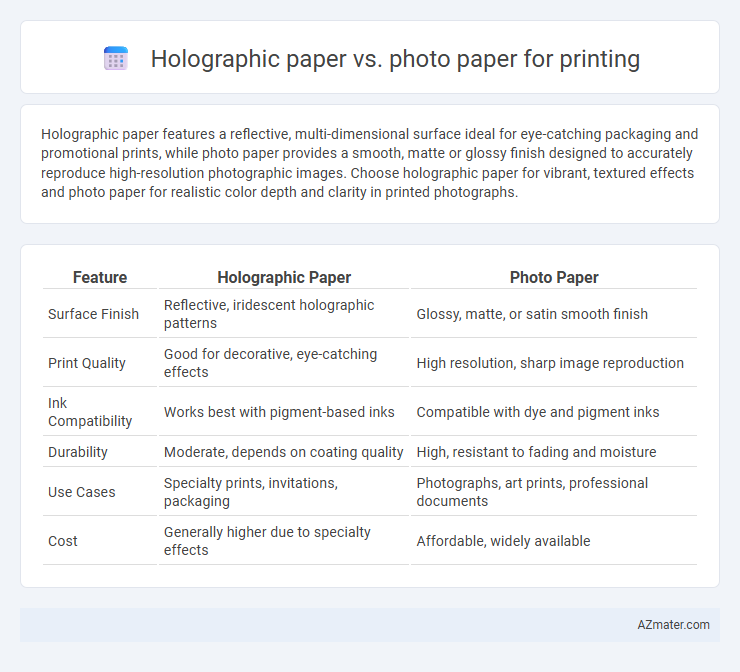Holographic paper features a reflective, multi-dimensional surface ideal for eye-catching packaging and promotional prints, while photo paper provides a smooth, matte or glossy finish designed to accurately reproduce high-resolution photographic images. Choose holographic paper for vibrant, textured effects and photo paper for realistic color depth and clarity in printed photographs.
Table of Comparison
| Feature | Holographic Paper | Photo Paper |
|---|---|---|
| Surface Finish | Reflective, iridescent holographic patterns | Glossy, matte, or satin smooth finish |
| Print Quality | Good for decorative, eye-catching effects | High resolution, sharp image reproduction |
| Ink Compatibility | Works best with pigment-based inks | Compatible with dye and pigment inks |
| Durability | Moderate, depends on coating quality | High, resistant to fading and moisture |
| Use Cases | Specialty prints, invitations, packaging | Photographs, art prints, professional documents |
| Cost | Generally higher due to specialty effects | Affordable, widely available |
Understanding Holographic Paper: Features and Uses
Holographic paper features a reflective, multi-dimensional surface created by microscopic patterns that diffract light, producing a vibrant, eye-catching effect ideal for decorative printing and packaging. Unlike traditional photo paper, which offers a smooth, high-gloss or matte finish optimized for sharp, color-accurate photographic prints, holographic paper enhances visual appeal through prismatic and shimmering effects that cannot be replicated by standard photo printing. Its common uses include promotional materials, artistic projects, and product labels where visual impact and uniqueness are key, distinguishing it from photo paper's primary function of high-quality photo reproduction.
What Is Photo Paper? Key Characteristics
Photo paper is a high-quality paper specifically designed for printing photographs with vivid colors and sharp details. Its surface is coated with a light-sensitive layer that enhances color accuracy, brightness, and contrast, making it ideal for inkjet and laser printers. Key characteristics include a glossy or matte finish, excellent color reproduction, and resistance to fading, ensuring long-lasting printed images.
Visual Impact: Holographic vs Photo Paper
Holographic paper delivers a striking visual impact with its dynamic, light-reflecting surface that creates a vibrant, three-dimensional hologram effect, making prints appear more eye-catching and futuristic. Photo paper, on the other hand, offers sharp, high-resolution image quality with true-to-life colors and fine details, ideal for capturing realistic photographs. While photo paper emphasizes clarity and color accuracy, holographic paper enhances visual appeal through its unique shimmering and multi-angle light diffraction properties.
Print Quality Comparison: Detail and Color Accuracy
Holographic paper delivers unique visual effects with shimmering patterns that enhance color vibrancy but can slightly reduce fine detail sharpness due to its textured surface. Photo paper is engineered for high-resolution printing, offering superior detail clarity and precise color accuracy, making it ideal for true-to-life photographic reproductions. When prioritizing print quality, photo paper excels in capturing intricate details and accurate colors, whereas holographic paper emphasizes dynamic light reflections over fine detail fidelity.
Applications: When to Choose Holographic or Photo Paper
Holographic paper is ideal for printing eye-catching promotional materials, greeting cards, and labels that benefit from light-reflective and dynamic visual effects, enhancing brand appeal and customer engagement. Photo paper excels in producing high-resolution images for photographs, portfolios, and art prints where color accuracy, detail, and longevity are crucial. Choose holographic paper to create striking, vibrant designs that require a metallic or prismatic finish, while photo paper is best suited for projects demanding true-to-life color reproduction and professional-grade image quality.
Durability and Longevity: Which Paper Lasts Longer?
Holographic paper features a specialized metallic coating that enhances resistance to fading, moisture, and scratches, making it highly durable for long-term displays. Photo paper, typically coated with a chemical layer designed for vibrant color absorption, may degrade faster when exposed to sunlight and humidity, resulting in color fading over time. For print longevity, holographic paper generally outperforms photo paper due to its protective surface that maintains visual impact and structural integrity longer under various environmental conditions.
Printing Technology Compatibility
Holographic paper typically requires specialized printing technologies such as UV printers or laser printers designed to adhere ink onto its reflective surface without smudging or distortion. Photo paper is compatible with a wider range of inkjet and dye-sublimation printers, providing smooth color absorption for high-resolution image reproduction. Understanding the compatibility of each paper type with specific printing technologies ensures optimal print quality and durability.
Cost Considerations: Price Differences
Holographic paper typically costs 2 to 4 times more than standard photo paper due to its specialized manufacturing process and unique reflective properties. Photo paper prices vary based on finish and quality, generally ranging from $0.10 to $0.50 per sheet, whereas holographic sheets often start around $0.50 and can exceed $2.00 per sheet depending on size and brand. Budget planning for printing projects should account for these significant price differences to balance visual impact with cost-efficiency.
Environmental Impact and Sustainability
Holographic paper often requires specialized coatings and metallic elements that can hinder recyclability and increase environmental waste compared to photo paper, which is typically more biodegradable and easier to recycle. Photo paper, especially when made from FSC-certified sources or recycled materials, generally has a lower carbon footprint and supports sustainable forestry practices. Choosing photo paper with eco-friendly inks further enhances sustainability, while holographic paper's production and disposal tend to have higher ecological impacts.
Choosing the Right Paper for Your Printing Needs
Holographic paper offers a unique, reflective finish ideal for eye-catching designs and promotional materials, while photo paper provides superior color accuracy and detail for high-quality photographic prints. Selecting the right paper depends on your project's purpose: choose holographic paper for vibrant, dynamic visuals and photo paper for sharp, true-to-life images. Consider factors like print type, durability, and desired visual effect to ensure the best outcome for your printing needs.

Infographic: Holographic paper vs Photo paper for Printing
 azmater.com
azmater.com